Menus
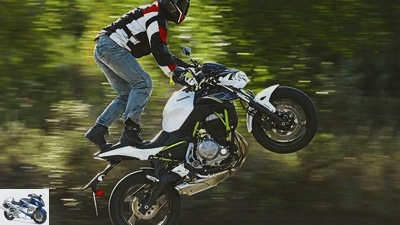
Kawasaki
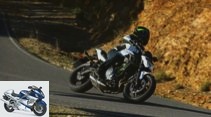
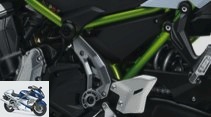
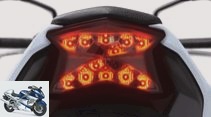

19th photos
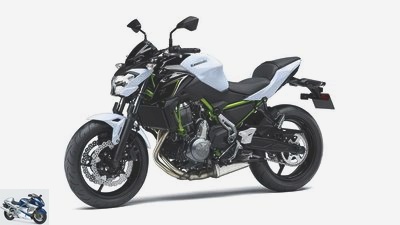
Kawasaki
1/19
The Kawasaki Z 650 is a predominantly newly designed bike and has little in common with its predecessor, the ER-6n. This also and especially applies to design
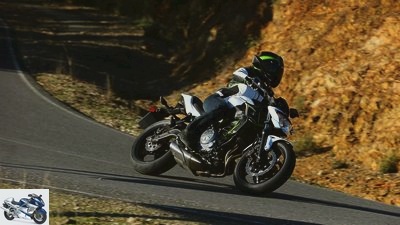
Kawasaki
2/19
Kawasaki Z 650
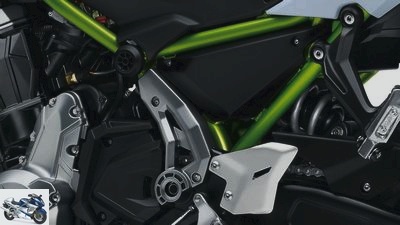
Kawasaki
3/19
The shock absorber is now centrally linked to the swing arm via a lever system. In general, it is softly tuned, but does not respond very sensitively. In addition, adjusting the spring base now becomes fiddly work
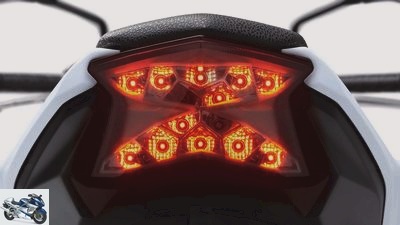
Kawasaki
4/19
Insiders immediately notice: LEDs on the rear light in a chic Z design

Kawasaki
5/19
Clear, compact, redesigned cockpit – now with gear indicator
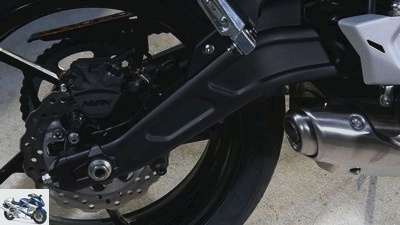
Kawasaki
6/19
Newly designed swing arm in the shape of a banana. The part helps to save weight. Overall, the Kawasaki Z 650 was a hefty kilo lighter than the ER-6n
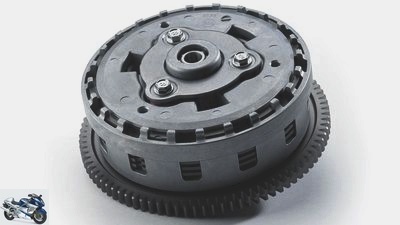
Kawasaki
7/19
With the Kawasaki Z 650 the slipper clutch (servo-assisted) finds its way into the middle class
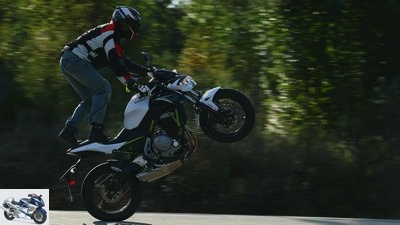
Moller-Tollner
8/19
Kawasaki Z 650
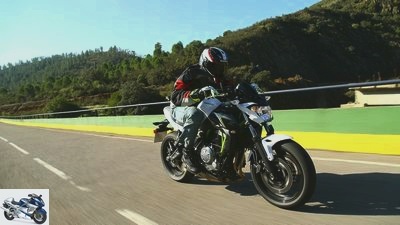
Kawasaki
9/19
Pictures from the HP driving report of the Kawasaki Z 650.
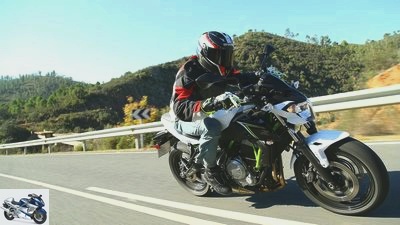
Kawasaki
10/19
Pictures from the HP driving report of the Kawasaki Z 650.
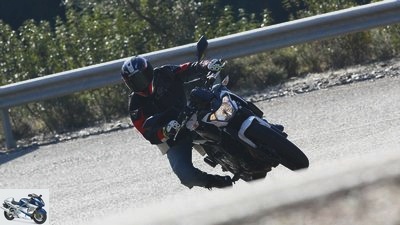
Kawasaki
11/19
Pictures from the HP driving report of the Kawasaki Z 650.
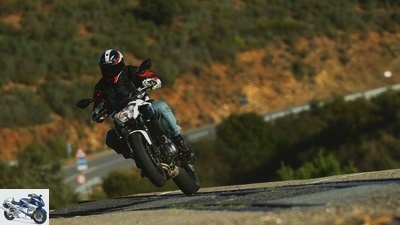
Kawasaki
12/19
Pictures from the HP driving report of the Kawasaki Z 650.
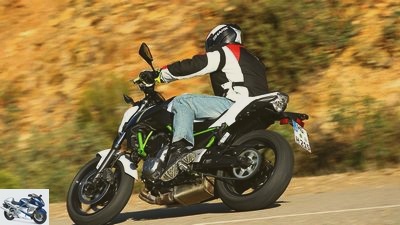
Kawasaki
13/19
Pictures from the HP driving report of the Kawasaki Z 650.

Kawasaki
14/19
Pictures from the HP driving report of the Kawasaki Z 650.
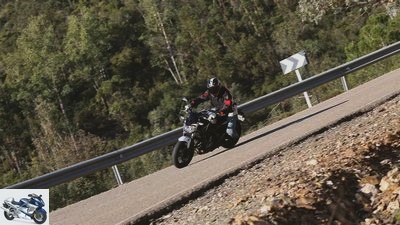
Kawasaki
15/19
Pictures from the HP driving report of the Kawasaki Z 650.
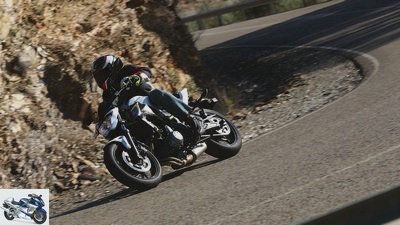
Kawasaki
16/19
Pictures from the HP driving report of the Kawasaki Z 650.
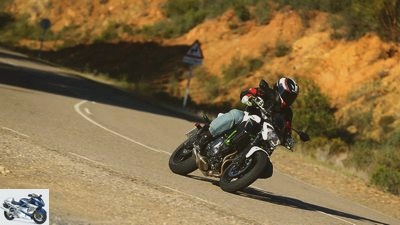
Kawasaki
17/19
Pictures from the HP driving report of the Kawasaki Z 650.
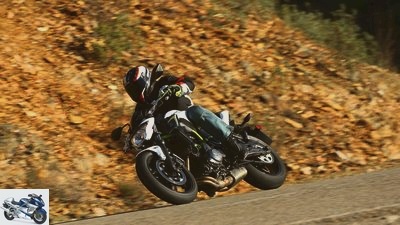
Kawasaki
18/19
Pictures from the HP driving report of the Kawasaki Z 650.
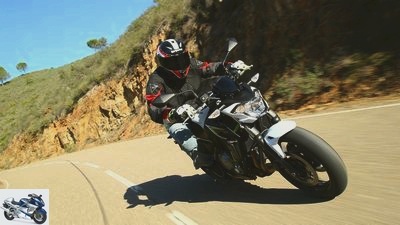
Kawasaki
19/19
Pictures from the HP driving report of the Kawasaki Z 650.
Kawasaki Z 650 in the HP driving report
Fair equivalent for 6,700 euros
Content of
The ER-6n is dead, long live the Kawasaki Z 650! Our first test drive shows whether the new Zett is just a slightly modified ER-6n with a more modern name.
First gear, 30 km / h, open the gas and pull the handlebars at the same time: Oops, that was a bit too much of a good thing! The front wheel of the Kawasaki Z 650 shoots unexpectedly fast and far towards the sky. Now brake quickly behind, otherwise there is a risk of going backwards by roll. At the first wheelie check, the little one surprises with a lot of punch in the middle, which favors such shows. But not only unicycle artists benefit from the changed engine characteristics of the row win from the predecessor ER-6n. Even normal people should be happy that they no longer have to squeeze the twin so hard for intermediate sprints. And the top performance cut from 72 to 68 hp? For free! At best, speed junkies complain about the somewhat restricted revving from around 8,000 rpm. Pushing instead of turning: Kawasaki went to great lengths to create a new driving experience.
Buy complete article
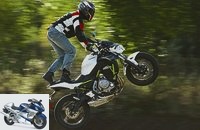
Kawasaki Z 650 in the HP driving report
Fair equivalent for 6,700 euros
Changes to the engine for the Kawasaki Z 650
The most important measures concern the timing and the changed throttle valve diameter. At point one, the technicians reduced the overlap, i.e. the point in time at which both valves are open at the same time. This increases the filling of the ignitable mixture in the combustion chamber, which increases the torque. As a second step, the Greens reduced the passage of the throttle valve from 38 to 36 millimeters. Effect: higher gas velocity, also better filling. The changed shape of the intake ducts also contributes to this. In addition, the airbox volume increased and the mixture is now atomized by new injection nozzles. The new exhaust with denser honeycomb inserts for the catalytic converters and a fresh mapping complete the changes to the engine. In addition, the servo-assisted anti-hopping clutch on the Kawasaki Z 650 prevents the rear wheel from jarring if downshifts occur prematurely. Despite the fine vibrations that accompany the characteristic two-cylinder pounding from medium engine speeds, the lively twin offers a very high level of entertainment. Especially since it sucks in threateningly dull and thunders out of the exhaust like a big one.
Kawasaki tinkered with the chassis even more than with the engine. Instead of a bridge frame, the Kawasaki Z 650 now uses a completely newly developed tubular steel mesh and an equally new swing arm. The manufacturer would like to have saved almost 13 kilos on these two components alone. The lighter wheels also contribute to the lower weight. Overall, Kawasaki promises a reduction of an impressive 19 to 187 kilos (with a full tank). The swing arm now picks up the shock absorber centrally via a lever system. We remember: In the ER-6 models, the monoshock was hinged directly to the side of the frame. Too bad that the adjuster of the spring base is now built in from both sides and the setting degenerates into fiddly work. Lighter wheels and different brake calipers (Nissin instead of Tokico), a seat position that has been lowered by 15 to 790 millimeters, and footrests that have been lowered by the same amount complete the most important chassis changes.
Accurate and stable in curves
But what do they bring? First and foremost, great handling. The Kawasaki Z 650 burns lightly through the winding asphalt strip. No curve is too tight for her, no combination too tricky. The steering head angle, which is half a degree steeper, and the reduced caster also contribute to this. Despite these handling-promoting changes, the small Kawasaki Z 650 storms precisely and stably in and around corners – line searching made easy. Only the setup of the spring elements raises questions. The remarkably softly coordinated fork moves quickly towards the stop when heavily anchored. The tire now has to absorb bumps and tends to lock up early as a result. There is also a lot of movement at the back at a brisk pace. But instead of responding comfortably like the fork, the shock absorber unabashedly hits the pilot with the bumps of striking bumps in the back – ouch!
The brakes are nice and crisp. Neither too sharp nor too slack, the performance increases in line with the braking force. However, the ABS continues to regulate early and at rough intervals. But despite all the criticism, it should be remembered: the Kawasaki Z 650 is neither an extremely expensive high-end racer nor a splendid super naked. Instead, it offers a fair value for just under 6,700 euros. This should not only please beginners and those returning to the sport, but also cause seasoned machinists who are interested in a second motorcycle to ponder. Especially since the Kawasaki Z 650 with its new, more aggressive design is following in the footsteps of its famous ancestors more than ever before.
Related articles
-
Driving report: Ducati Monster 796
fact 10 pictures Ducati 1/10 Iom 78: On the Isle of Man (IOM) Mike Hailwood wrote another chapter in Ducati history in 1978: he came, saw and won in …
-
Kawasaki Z 650 in the driving report
Kawasaki 9 photos Kawasaki 1/9 Photo gallery: Kawasaki Z 650 in the driving report. Kawasaki 2/9 The diet worked: Compared to the ER-6n, the Z 650 has…
-
Driving report: LSL-Kawasaki W 800 TR
Gargolov 13 photos Manufacturer 1/13 Noble bike from Krefeld: LSL Clubman W 800 TR. Manufacturer 2/13 Noble bike from Krefeld: LSL Clubman W 800 TR….
-
Driving report Yamaha WR 400 F
Driving report Yamaha WR 400 F Light and cross With the WR 400 F, which is derived from the new Moto Cross model YZ 400 F, Yamaha wants to revolutionize…
-
Kawasaki Z 900 – first driving impressions
Kawasaki 47 pictures Kawasaki 1/47 Kawasaki Z 900 at the EICMA 2016. Kawasaki 2/47 Kawasaki Z 900 at the EICMA 2016. Kawasaki 3/47 Kawasaki Z 900 at the …
-
Driving report Triumph Thunderbird with Big-Bore-Kit
triumph 11 photos triumph 1/11 Triumph Thunderbird triumph 2/11 Triumph Thunderbird triumph 3/11 Triumph Thunderbird triumph 4/11 Triumph Thunderbird…
-
First driving report of the Kawasaki GPZ 900 R (MOTORRAD 1-1984)
Archive 26 pictures Archive 1/26 Light, strong and fast was the formula for the Kawasaki superbike of the 1980s, the GP Z 900 R. Archive 2/26 According to …
-
Ducati XDiavel S in the driving report
Ducati 13 pictures Ducati 1/13 The XDiavel is – apart from the Indiana 650 from the 80s – the first cruiser in the company’s history. Ducati 2/13 …
-
Honda X-ADV (2017) in the driving report
Honda 28 photos Ciro Meggiolaro 1/28 Neo-Scooter: Honda is creating a completely new scent trail in the large scooter segment. The X-ADV is said to be…
-
Honda CRF 1100 L Africa Twin (2020) in the driving report
Motorcycle fair in Milan EICMA 2019 Presented by Honda 14th photos Honda 1/14 The base model Honda CRF 1100 L Africa Twin comes exclusively with the…